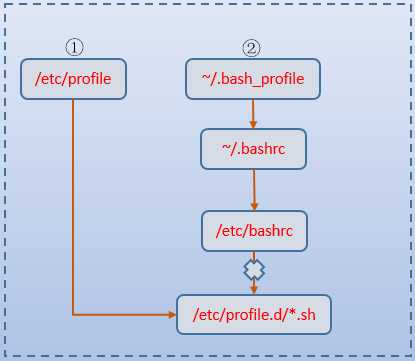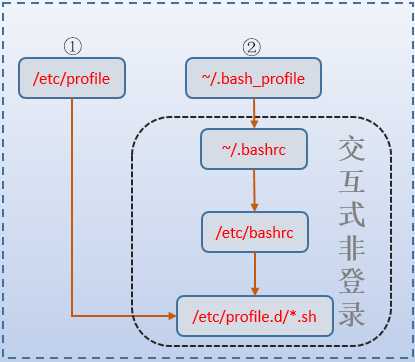交互式shell和非交互式shell,登录shell和非登录shell的区别
Posted
tags:
篇首语:本文由小常识网(cha138.com)小编为大家整理,主要介绍了交互式shell和非交互式shell,登录shell和非登录shell的区别相关的知识,希望对你有一定的参考价值。
参考技术A 交互式模式就是shell等待你的输入,并且执行你提交的命令。这种模式被称作交互式是因为shell与用户进行交互。这种模式也是大多数用户非常熟悉的:登录、执行一些命令、签退。当你签退后,shell也终止了。shell也可以运行在另外一种模式:非交互式模式。在这种模式下,shell不与你进行交互,而是读取存放在文件中的命令,并且执行它们。当它读到文件的结尾,shell也就终止了。本回答被提问者和网友采纳
bash启动时加载配置文件过程
当用户登录系统时,会加载各种bash配置文件,还会设置或清空一系列变量,有时还会执行一些自定义的命令。这些行为都算是启动bash时的过程。
另外,有些时候登录系统是可以交互的(如正常登录系统),有些时候是无交互的(如执行一个脚本),因此总的来说bash启动类型可分为交互式shell和非交互式shell。更细分一层,交互式shell还分为交互式的登录shell和交互式非登录shell,非交互的shell在某些时候可以在bash命令后带上"--login"或短选项"-l",这时也算是登录式,即非交互的登录式shell。
判断是否交互式、是否登录式
判断是否为交互式shell有两种简单的方法:
方法一:判断变量"-",如果值中含有字母"i",表示交互式。
[root@localhost ~]# echo $- himBH [root@localhost ~]# vim a.sh #!/bin/bash echo $- [root@localhost ~]# bash a.sh hB
方法二:判断变量PS1,如果值非空,则为交互式,否则为非交互式,因为非交互式会清空该变量。
[root@localhost ~]# echo $PS1 [u@h W]$
判断是否为登录式的方法也很简单,只需执行"shopt login_shell"即可。值为"on"表示为登录式,否则为非登录式。
[root@localhost ~]# shopt login_shell
login_shell on
[root@localhost ~]# bash [root@localhost ~]# shopt login_shell login_shell off
所以,要判断是交互式以及登录式的情况,可简单使用如下命令:
echo $PS1;shopt login_shell # 或者 echo $-;shopt login_shell
几种常见的bash启动方式
(1).正常登录(伪终端登录如ssh登录,或虚拟终端登录)时,为交互式登录shell。
[root@localhost ~]# echo $PS1;shopt login_shell [u@h W]$ login_shell on
(2).su命令,不带"--login"时为交互式、非登录式shell,带有"--login"时,为交互式、登录式shell。
[root@localhost ~]# su - root [root@localhost ~]# echo $PS1;shopt login_shell [u@h W]$ login_shell on
(3).执行不带"--login"选项的bash命令时为交互式、非登录式shell。但指定"--login"时,为交互式、登录式shell。
[root@localhost ~]# echo $PS1;shopt login_shell [u@h W]$ login_shell on
(4).使用命令组合(使用括号包围命令列表)以及命令替换进入子shell时,继承父shell的交互和登录属性。
[root@localhost ~]# (echo $BASH_SUBSHELL;echo $PS1;shopt login_shell) 1 [u@h W]$ login_shell on
(5).ssh执行远程命令,但不登录时,为非交互、非登录式。
[root@localhost ~]# ssh localhost ‘echo $PS1;shopt login_shell‘ The authenticity of host ‘localhost (::1)‘ can‘t be established. RSA key fingerprint is 3d:68:48:4c:16:55:da:9e:54:10:29:34:3e:6a:61:fb. Are you sure you want to continue connecting (yes/no)? yes Warning: Permanently added ‘localhost‘ (RSA) to the list of known hosts. root@localhost‘s password: login_shell off
加载bash环境配置文件
无论是否交互、是否登录,bash总要配置其运行环境。bash环境配置主要通过加载bash环境配置文件来完成。但是否交互、是否登录将会影响加载哪些配置文件,除了交互、登录属性,有些特殊的属性也会影响读取配置文件的方法。
bash环境配置文件主要有/etc/profile、~/.bash_profile、~/.bashrc、/etc/bashrc和/etc/profile.d/*.sh,为了测试各种情形读取哪些配置文件,先分别向这几个配置文件中写入几个echo语句,用以判断该配置文件是否在启动bash时被读取加载了。
echo "echo ‘/etc/profile goes‘" >>/etc/profile echo "echo ‘~/.bash_profile goes‘" >>~/.bash_profile echo "echo ‘~/.bashrc goes‘" >>~/.bashrc echo "echo ‘/etc/bashrc goes‘" >>/etc/bashrc echo "echo ‘/etc/profile.d/test.sh goes‘" >>/etc/profile.d/test.sh chmod +x /etc/profile.d/test.sh
①.交互式登录shell或非交互式但带有"--login"(或短选项"-l",例如在shell脚本中指定"#!/bin/bash -l"时)的bash启动时,将先读取/etc/profile,再依次搜索~/.bash_profile、~/.bash_login和~/.profile,并仅加载第一个搜索到且可读的文件。当退出时,将执行~/.bash_logout中的命令。
但要注意,在/etc/profile中有一条加载 /etc/profile.d/*.sh 的语句,它会使用source加载/etc/profile.d/下所有可执行的sh后缀的脚本。
[root@localhost ~]# grep -A 8 *.sh /etc/profile for i in /etc/profile.d/*.sh ; do if [ -r "$i" ]; then if [ "${-#*i}" != "$-" ]; then . "$i" else . "$i" >/dev/null 2>&1 fi fi done
内层if语句中的 "${-#*i}" != "$-" 表示将"$-"从左向右模式匹配"*i"并将匹配到的内容删除(即进行变量切分),如果"$-"切分后的值不等于"$-",则意味着是交互式shell,于是怎样怎样,否则怎样怎样。
同样的,在~/.bash_profile中也一样有加载~/.bashrc的命令。
[root@localhost ~]# grep -A 1 ~/.bashrc ~/.bash_profile if [ -f ~/.bashrc ]; then . ~/.bashrc fi
而~/.bashrc中又有加载/etc/bashrc的命令。
[root@localhost ~]# grep -A 1 /etc/bashrc ~/.bashrc if [ -f /etc/bashrc ]; then . /etc/bashrc fi
其实/etc/bashrc中还有加载 /etc/profile.d/*.sh 的语句,但前提是非登录式shell时才会执行。以下是部分语句:
if ! shopt -q login_shell ; then # We‘re not a login shell ... for i in /etc/profile.d/*.sh; do if [ -r "$i" ]; then if [ "$PS1" ]; then . "$i" else . "$i" >/dev/null 2>&1 fi fi done ... fi
从内层if语句和/etc/profile中对应的判断语句的作用是一致的,只不过判断方式不同,写法不同。
因此,交互式的登录shell加载bash环境配置文件的实际过程如下图:

以下结果验证了结论:
Last login: Mon Aug 14 04:49:29 2017 # 新开终端登录时 /etc/profile.d/*.sh goes /etc/profile goes /etc/bashrc goes ~/.bashrc goes ~/.bash_profile goes
[root@localhost ~]# ssh localhost The authenticity of host ‘localhost (::1)‘ can‘t be established. ECDSA key fingerprint is SHA256:ADR6o4CtLxt00cZpKBtPwsloQD6SsAA/78Drd+UKopo. ECDSA key fingerprint is MD5:4d:a4:85:4c:4b:c0:b3:31:93:94:21:65:d4:c5:b2:c4. Are you sure you want to continue connecting (yes/no)? yes Warning: Permanently added ‘localhost‘ (ECDSA) to the list of known hosts. root@localhost‘s password: Last login: Fri Dec 6 19:53:41 2019 from 192.168.1.5 /etc/profile.d/*.sh goes /etc/profile goes /etc/bashrc goes ~/.bashrc goes ~/.bash_profile goes
之所以执行shell脚本时没有显示执行 /etc/profile.d/*.sh ,是因为它是非交互式的,根据/etc/profile中的 if [ "${-#*i}" !="$-" ] 判断,它将会把 /etc/profile.d/*.sh 的执行结果重定向到/dev/null中。也就是说,即使是shell脚本(带"--login "选项),它也加载了所有bash环境配置文件。
②.交互式非登录shell的bash启动时,将读取~/.bashrc,不会读取/etc/profile和~/.bash_profile、~/.bash_login和~/.profile。
因此,交互式非登录shell加载bash环境配置文件的实际过程为下图内方框中所示:

以上是关于交互式shell和非交互式shell,登录shell和非登录shell的区别的主要内容,如果未能解决你的问题,请参考以下文章